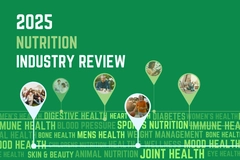
- Industry news
Industry news
- Category news
- Reports
- Key trends
- Multimedia
Multimedia
- Journal
- Events
- Suppliers
Suppliers
- Home
- Industry news
Industry news
- Category news
- Reports
- Key trends
- Multimedia
Multimedia
- Events
- Suppliers
Suppliers
Real-world proof: A third of type 2 diabetes patients in remission with “soups and shakes” diet

08 Aug 2024 --- Research indicates that 32% of people with type 2 diabetes completing the UK’s National Health Service (NHS) Type 2 Diabetes Path Remission (T2DR) program put their diabetes into remission. These patients don’t need to take medication to regulate their blood sugar levels after. The year-long program offers participants nutritionally balanced, low-calorie products, such as soups and shakes, as meal replacements, combined with support from healthcare professionals.
Additionally, participants reported significant weight loss over the program. The 940 participants who completed the one-year program reported a mean weight loss of 9.3% or 10.3 kg. In comparison, researchers recorded an average weight loss of 8.3% or 9.4 kg for all 1,710 participants who joined the program before January 2022.
Although remission rates are lower than reported in clinical trials for the same program (46%), the researchers note that the current findings “complement the clinical efficacy findings from randomized controlled trial settings, providing important evidence on the clinical effectiveness of the total diet replacement (TDR) approach when delivered at scale in real-world settings.”
Commenting on the study, professor Calum Sutherland, an expert in type 2 diabetes at the University of Dundee’s School of Medicine, UK, says that the “work by Dr. Valhabji and colleagues represents a significant step forward in our fight to reduce the chronic health problems that develop in people living with type 2 diabetes.”
“Their work confirms that the NHS can deliver diet replacement therapy for diabetes remission to large numbers of people diagnosed with type 2 diabetes in the last six years. This program significantly reduces weight, improves glucose control and removes the need for medications in one in three of those who complete the program within 12 months.”
Real-world program
The NHS and the charity Diabetes UK established the T2DR program in 2020 to support weight loss and maintenance, reduce glucose-lowering medication and potential remission of type 2 diabetes. It draws on evidence from the Diabetes Remission Clinical Trial (DiRECT) and the Doctor Referral of Overweight People to Low Energy Total Diet Replacement Treatment (DROPLET) randomized controlled trial.
Eligible participants receive low-calorie TDR products, including soups and shakes, that provide 800 to 900 kcal daily for 12 weeks. They replace all normal meals with these products.
 After three months of meal replacement products, participants receive support to reintroduce foods.In addition, participants receive support and monitoring for 12 months, which includes helping to reintroduce food after the initial 12 weeks of meal replacement products. They can choose to receive this support in person or digitally.
After three months of meal replacement products, participants receive support to reintroduce foods.In addition, participants receive support and monitoring for 12 months, which includes helping to reintroduce food after the initial 12 weeks of meal replacement products. They can choose to receive this support in person or digitally.
Although not part of the research team, Dr. Dimitrios Koutoukidis, senior researcher at the University of Oxford, UK, notes that the weight loss reported in the research is similar to that in the controlled research studies.
“There are two key differences between the NHS T2DR program and other forms of restrictive dieting. Firstly, people don’t try to lose weight independently but receive support to help them succeed. Secondly, the soups and shakes used in the program are regulated to ensure they are safe and nutritious.”
“These results can encourage clinicians to continue referring people to an effective program. Additionally, people with type 2 diabetes might consider this program a good option for achieving diabetes remission.”
Since the NHS fully funds the program, there is no cost to participants.
People can be referred to the program if they are between 18 and 65 years old, received a type 2 diabetes diagnosis within the last six years and have a body mass index (BMI) over 27 kg/m2 for people from White ethnic groups or a BMI over 25 kg/m2 for people from Black, Asian and other ethnic groups.
Starting vs. completing the program
Since the program’s launch, 7,540 people have been referred to it. The study, published in The Lancet Diabetes & Endocrinology, includes data from 1,710 people who started the program before January 1, 2022, of which 945 participants completed the whole program.
The mean participation time was eight months, with 84% reaching the end of the three-month meal replacement phase. Researchers indicate that people who were most likely to complete the program were aged 50–65, female, White, had diabetes for less than a year, had a BMI of 30 to 40, following digital coaching and had a baseline blood glucose (HbA1c) level on the lower side — between 43 and 64 mmol/mol.
 Although remission rates were lower than in clinical trials, reported weight loss was similar.Reasons for participants’ early withdrawal include psychological reasons, multiple life events, living with severe depression and other health issues. Participants also reported that program support “might have been overly tailored to Western diets and cultural norms,” note the researchers.
Although remission rates were lower than in clinical trials, reported weight loss was similar.Reasons for participants’ early withdrawal include psychological reasons, multiple life events, living with severe depression and other health issues. Participants also reported that program support “might have been overly tailored to Western diets and cultural norms,” note the researchers.
Remission rates and weight loss were more significant for people who completed the program. Researchers measured remission rates for subgroups of participants who had two recorded HbA1c measurements — 710 people who started before January 2022 and 450 who completed the program. In this first group, 27% were in remission, compared to 32% of people who completed the program.
The 27% in remission had a mean HbA1c reduction of 12 mmol/mol and a mean weight loss of 13.4% or 14.8 kg. The group who completed the program and was in remission recorded a mean weight loss of 14.4% or 15.9 kg.
Weight loss benefits
Professor Sutherland underscores that people who lose the most weight get the most significant health benefits.
“While this number is less than achieved in the smaller clinical trials that preceded this work, it still represents the most impressive level of remission of type 2 diabetes seen by any health intervention in the general population,” he explains. “There are well-established health benefits associated with all of these outcomes, including lowering the risk of chronic kidney and heart disease, and should therefore greatly improve the quality of life of the patients.”
In addition, he highlights that the outcomes will benefit the NHS.
“The costs required to generate this level of diabetes remission will be much lower than current costs to treat the health problems that develop in almost everyone with type 2 diabetes over time (it currently requires around 10% of the entire NHS budget to manage diabetes).”
 The costs to generate this level of remission are lower than current costs to treat health problems in people with type 2 diabetes.Sutherland cautions that continued monitoring of participants is vital to ensure their diabetes does not return. At the same time, he highlights “strong evidence that even a few years of remission greatly improves the long-term health outlook for these individuals.”
The costs to generate this level of remission are lower than current costs to treat health problems in people with type 2 diabetes.Sutherland cautions that continued monitoring of participants is vital to ensure their diabetes does not return. At the same time, he highlights “strong evidence that even a few years of remission greatly improves the long-term health outlook for these individuals.”
According to Diabetes UK, the charity that initiated the program with NHS England, recent DiRECT results show that people can stay in type 2 diabetes remission for at least five years.
Program improvements
The researchers caution that not everyone who was referred to the program started TDR, and some people declined the referral. They note that the program and intervention are “clearly not acceptable to everybody and must be considered as just one treatment pathway in a portfolio of potential options for weight loss, including other dietary strategies, pharmacotherapy and bariatric surgery.”
Moreover, they highlight several limitations of the current study. For example, it used observational data without a control group. Participants on remote and digital deliveries self-reported their weight, which may be inaccurate.
The researchers could only calculate a remission for 42% of participants who started the program with HbA1c measurements and data from the National Diabetes Audit.
The study assessed the program’s effect by dimensions of inequalities, which were not available in earlier clinical trials. The researchers note that their findings “can support better-informed policy decisions regarding the TDR approach in terms of operational effectiveness and effect on population health.”
According to the researchers, the study’s results have informed a new program specification that is available across England. This year, the NHS D2PR program will become available in 42 local health areas, compared to 21 in 2023.
By Jolanda van Hal











